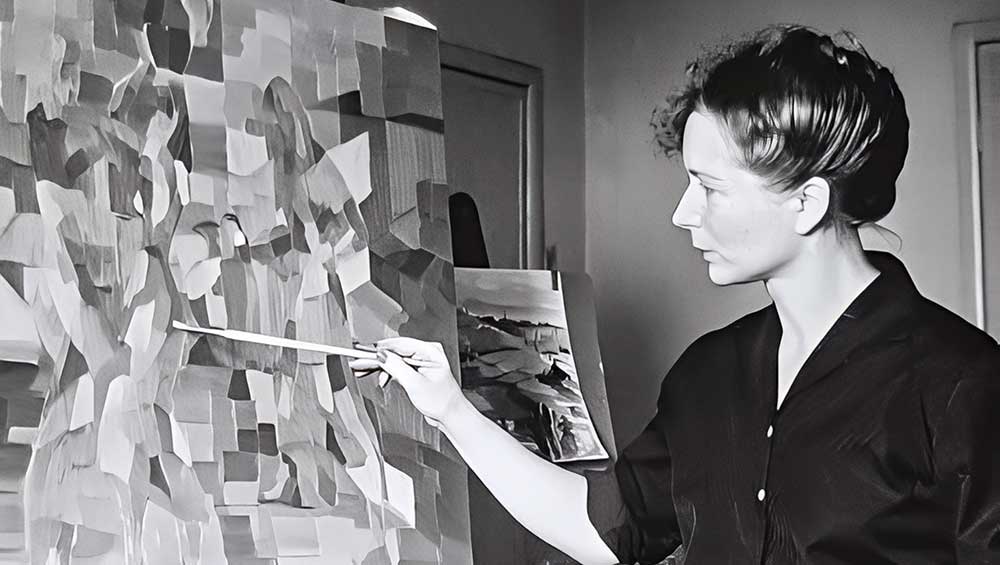
Hélène de Beauvoir. Courtesy Amar Gallery, © APP, Ute Achhammer.
Amar Gallery, London
23 January – 30 March 2025
by ANNA McNAY
As an only child, I have never known the misery of being a second child destined to only ever be second best. This was something Hélène de Beauvoir (1910-2001) lived with from the day she was born. Two years younger than her sister, Simone, she failed her aristocratic parents at conception by not being a boy.1 With blond plaits and light blue eyes, she was nicknamed “Poupette” (“little doll”), and, from an early age, she could be found with her pencils, drawing and copying illustrations from books. Her gestures were sure and quick, even as a child.2 Nonetheless, her father, Georges de Beauvoir, was interested only in the academic success of his elder daughter. Furthermore, he considered Simone’s character to demand exceptional treatment, stating: “Oh, you shouldn’t interfere with Simone or she’s going to have a fit.” Hélène, on the other hand, was not spared. While she bore it well, she often sought refuge in her sister’s arms. Despite the unfair treatment, they were incredibly close.3 Together they played a game, whereby Simone would write stories that she would read out loud, one chapter at a time, and Hélène would make fitting illustrations.4 As they grew older, they became one another’s best friends. Simone recalls in her memoirs: “My sister joined me several times on these evenings out; in order to give herself a ‘low-class’ appearance she would wear her hat on one side and pull her skirts up over her crossed knees. We would talk loudly and laugh at the tops of our voices. Or we would enter a bar separately, pretending not to know one another and then we would start to fight: we would tear each other’s hair, scream insults at one another, and feel very gratified if such an exhibition diverted the public for a few minutes.”5
In her career as an artist – one at least in part selected so as to be something quite different from the chosen path of her sister – Hélène was supported by Simone in much the same way as Vincent van Gogh was by his brother, Theo. The elder sister paid for her sibling’s materials, her studio, her exhibitions, and the transport of herself and her works when necessary. Over more than six decades, Hélène made in excess of 3,000 paintings and works on paper, and she had many exhibitions, including in America. This, however, is her first one in London. Amar Singh, the director of Amar Gallery, where it is being held, and who says: “Our whole mission is to search for overlooked artists,” spent three years putting the show together, sourcing works from around the world, meeting patrons of De Beauvoir and discovering her importance to her sister and the global feminist movement. The artist published her memoirs in 1987; had a book devoted to her painting published in 1991; was the subject, in 2004, along with Simone, of a memoir by their friend, the women’s rights specialist Claudine Monteil; and had a monograph published in German in 2014.
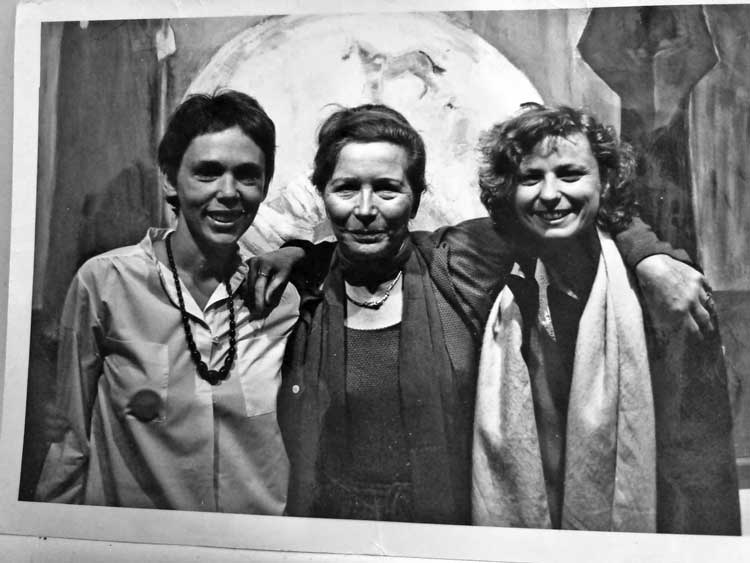
Left to right: feminist Kathie Sarachild, Hélène de Beauvoir, Claudine Monteil. NYC, 1979. Image copyright Claudine Monteil. Courtesy Amar Gallery, © APP, Ute Achhammer.
So why has no one heard of Hélène de Beauvoir? In part, it is second-child syndrome. But it is also because she was never truly part of the Parisian art scene. She married Lionel de Roulet, then a professor of philosophy and Jean-Paul Sartre’s “young disciple”, in December 1942, and followed him in his role of diplomat from country to country – Portugal; the then Yugoslavia, where she complained: “But Lionel, how do you expect me to paint? There are only factories, chimneys and barbed wire in these landscapes!”;6 Morocco; and Italy – before settling in the small village of Goxwiller, 30km from Strasbourg, in Alsace. In her memoir, Monteil describes her first visit to Goxwiller in 1975 and the large living room with Louis XIV chairs, scratched by Hélène’s two Abyssinian cats, Tëtka and Pimpernel, where she did her engravings by the window, looking out on to typical Alsatian buildings across the road and a goldfish pond in the garden. Her studio, in the adjoining house, scented with lapsang souchong, Monteil describes as: “Bathed in light, it looked out over rose bushes and flowers. On a pedestal next to a jar filled with brushes were some framed photographs of Sartre and Simone. Paintings were piled up everywhere … Women and children, lions, tigers and other animals paraded before my eyes; the style combined the abstract and the naive.”7 In a speech at Amar Gallery, Monteil additionally noted that Hélène would paint to the soundtrack of Maria Callas, and she described her as: “Gentle and smiley and relaxed and cheerful and fun and brilliant – so different from Simone!”8
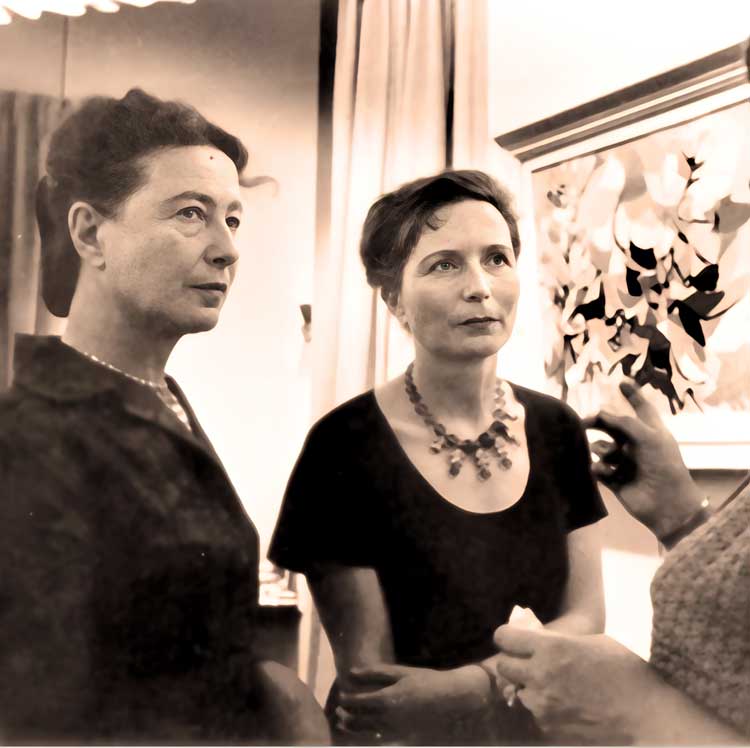
Left to right: Simone de Beauvoir, Hélène de Beauvoir, at Hélène de Beauvoir's exhibition opening, 1960s. Copyright All Rights Reserved. Courtesy Amar Gallery, © APP, Ute Achhammer.
De Beauvoir’s parents had prohibited her from attending the Parisian Beaux-Arts academy due to the bad reputation of some of its students, so, instead, she studied at a school for art and advertising a few hundred yards from their home. Here she learned a variety of skills, beginning with woodcuts and, later, etching. This enabled her to make some money of her own by doing book illustration.9 The title of this exhibition, The Woman Destroyed, comes from a collection of short stories written by Simone in 1967,10 for which the author suggested that Hélène create engravings to illustrate the issues and the distress of the women she had described.11 Such a collaboration had long been a dream of the sisters. Monteil records Hélène as saying: “I had painted watercolours for L’Invitée and [etchings] for Tous les Hommes Sont Mortels, but none of these illustrations had ever been published. After all, Simone’s books were already quite voluminous on their own. La Femme Rompue [The Woman Destroyed], on the other hand, was a short story short enough to accommodate [etchings]. Illustrating this text provoked a revelation in me: pictorially translating what goes on in the mind of a female being implied an intimacy with that person’s spirit, an adherence whose strength I had not suspected.”12 One hundred and forty-three first-edition copies were published by Editions Gallimard, with 16 etchings by Hélène. While the response to the stories was unkind, with Le Figaro Littéraire calling it a “novel for shop girls,”13 La Quinzaine Littéraire hailed Hélène's etchings: “It [sic] gives off an impression of loneliness and distress that suits the text, and the complicity between the established novelist and the well-known artist is moving.” Centre Matin also praised Hélène's work: “The illustration adds a new dimension to the text. With her arabesque strokes and the infinite play of black and white, Hélène de Beauvoir goes further into the sensual than Simone de Beauvoir’s text ever could.”14 Singh is lucky enough to have got his hands on one of these rare first editions, and it is on display in the exhibition. Sadly, however, it is confined to a glass case (understandable) and unopened (less so). Further sadly, none of De Beauvoir’s print works are on display.
De Beauvoir showed promise from early on, with her first exhibition, at Galerie Bonjean in Paris, in January 1936, attracting a large crowd to its vernissage. Amazingly, this crowd included Picasso, who commented that De Beauvoir’s work was “original”. At 25, she was the first of the siblings to have success. Newspaper reviews were also positive, with Les Débats describing her talent as “personal and forceful”, and L’Européen echoing Picasso by writing: “In her work there is no influence to be seen other than that of a very classical tradition that gives her certainty of style and compositional balance.”15
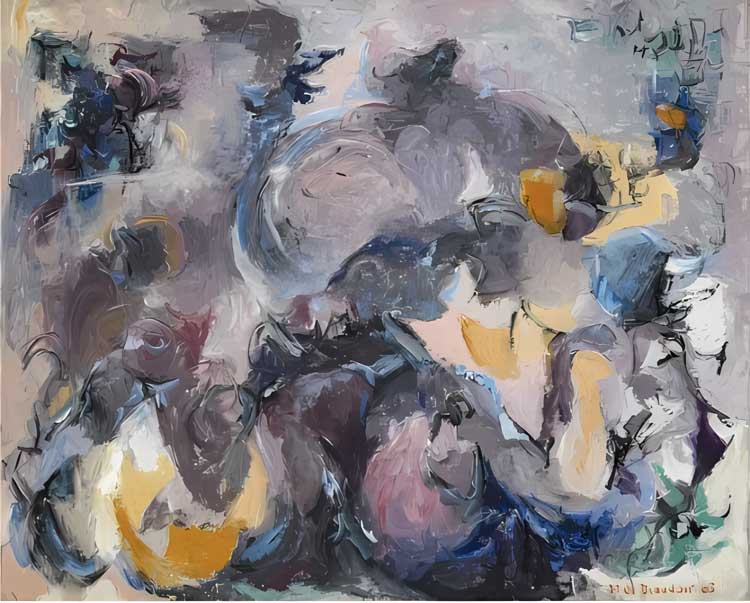
Hélène de Beauvoir. Untitled, 1963. Acrylic on canvas, 81 x 100 cm. Courtesy Amar Gallery, © APP, Ute Achhammer.
The current exhibition features 21 paintings and works on paper from the 1950s to the 1980s. A number of these are, from a distance, predominantly grey, and, at first sight, did nothing for me. Close up, however, they reveal themselves to be deceptively intriguing. Untitled (1963), for example, appears to hide Chinese characters (I don’t think it actually does!) amid the grey swirls, and there are swathes of a most juicy and delicious peach colour glimmering through the monotone. These works also show the early appearance of harlequin-like patterns in De Beauvoir’s compositions. As Simone wrote in a text for the catalogue to accompany an exhibition of 100 of Hélène’s paintings at the Palace of Arts and Culture in Brest in April 1975: “She always refused both the constraint of imitation and the aridity of abstraction. She found an ever-more expert balance between formal inventions and references to reality.”16
_Rice-Field-Workers,-c1940s.jpg)
Hélène de Beauvoir. Rice Field Workers, c1940s. Watercolour on paper. 38 x 51.2 cm. Courtesy Amar Gallery, © APP, Ute Achhammer.
Monteil also cites De Beauvoir as saying: “Oil painting is my drug, I love working with it, I love its fluidity, the flexibility of its technique, and I love the smell of turpentine.”17 Nevertheless, she also made watercolours, of which an enchantingly beautiful selection is on display. Several mountain landscapes and port scenes (all simply “c1950s”) and a fantastic Rice Field Workers (c1940s) in which there are so few lines, yet every imaginable detail of the scene is captured and brought to life. There are also a couple of pieces titled simply Abstract Forms (c1950s).

Hélène de Beauvoir. Abstract Forms, c1950s. Watercolour on paper. Courtesy Amar Gallery, © APP, Ute Achhammer.
One of these quite clearly belongs to the port series, evoking a bay with a jetty and fishing boats and cottages on the hills in the distance – in fact, it is not all that abstract; the other is much looser, quite unlike the other watercolours, yet, to my mind, evincing a church, a bird and … could it be cyclists? The sense of motion is felt, and this is something that carries through all De Beauvoir’s work. The title of these two pieces again references her desire to remain in that liminal space of being neither one thing nor the other (neither wholly abstract nor wholly figurative) – or maybe both at once. As with my imagined Chinese characters in Untitled (1963) above, the mark-making in all the watercolours is decidedly calligraphic: painting is Hélène’s way of writing.
.jpg)
Hélène de Beauvoir's painter studio in Milano, 1955. Copyright Claudine Monteil. Courtesy Amar Gallery, © APP, Ute Achhammer.
From 1949, Hélène and Lionel spent several years in Casablanca, and, in the early 1950s, they relocated to Milan, from where Hélène was able to visit Venice. In both places, she was very influenced by the warm and dazzling light. As Monteil writes: “Thrilled with the light and colours of Venice, she had brought back from a stay there her Variations sur Venise. Rather than mixing hues, she had juxtaposed them, playing with the perspective … Space held a primordial place in her paintings. She was still groping to find her own style. Looking to differentiate herself from what was fashionable, she had given up on studying perspective in accordance with Renaissance ideas. She had thus spontaneously turned to the abstract.”18 Two reviews of an exhibition of her Venetian paintings in Paris in 1954 concluded similarly: “The sum total breathes a syncopated musicality and is bathed in a dazzling light,”19 and: “Through her constructions in air and light, Hélène de Beauvoir has produced her own talent, confirmed her intentions, which are to bring together landscape and the image of the human being.”20
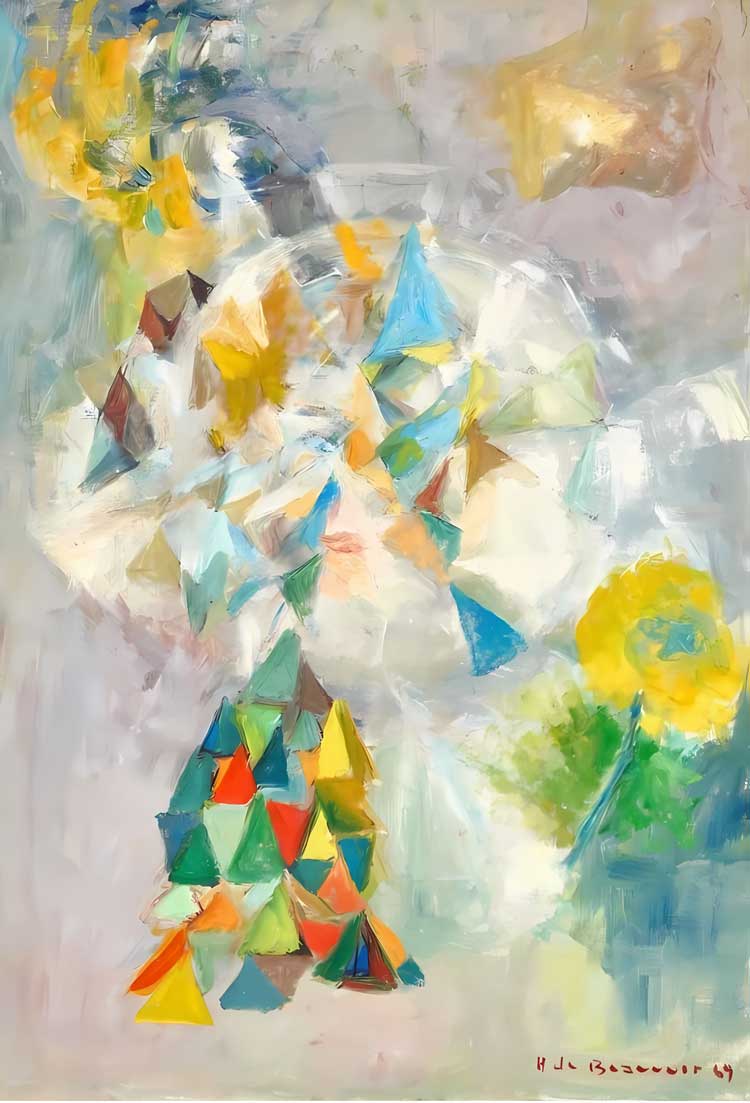
Hélène de Beauvoir. Face in a Broken Mirror, 1969. Oil on canvas, 73 x 50 cm. Courtesy Amar Gallery, © APP, Ute Achhammer.
This play with refraction, creating a kaleidoscopic effect, is seen here beautifully in the slightly later Face in a Broken Mirror (1969). Fragmentation, shards, sharp, cutting edges – the danger of the broken glass is evident, yet look more closely and you can just about discern the features of a face: an eye, an eyebrow and lips – and from that eye, sparkling a bright pale blue, we recognise it as the artist’s self-portrait.
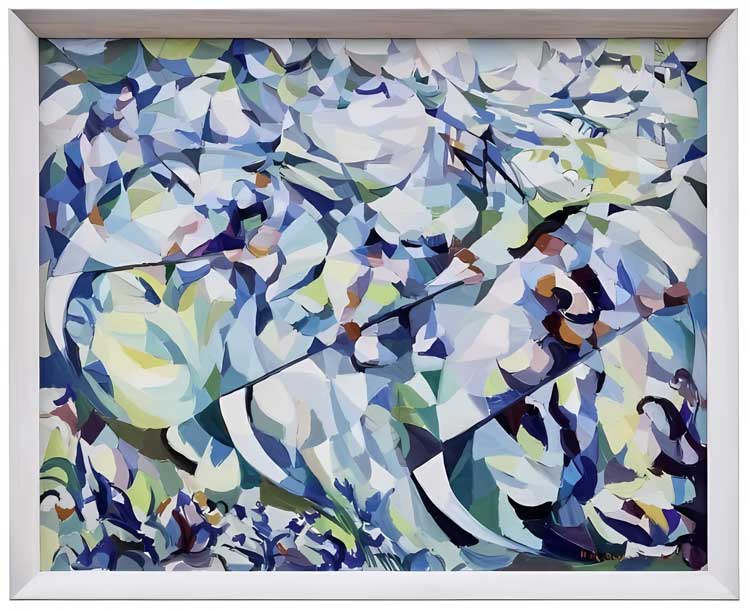
Hélène de Beauvoir. The Haymakers II, 1957. Oil on canvas, 65 x 81 cm. Courtesy Amar Gallery, © APP, Ute Achhammer.
This geometrically abstracted style of painting is also seen in pictures such as Skiers (1957) and The Haymakers II (1957), which bring to mind early-20th-century Italian futurist works, such as Umberto Boccioni’s Dynamism of a Cyclist (1913) or Giacomo Balla’s Abstract Speed and Sound (1913-14), which De Beauvoir may well have seen while living in Milan. In the case of the skiers, the broken-up, angular shapes, held within the larger confines of sweeping circular swirls, perfectly capture the sense of the warmly clad figure on his long, straight skis hurtling slalom-style down the mountainside.
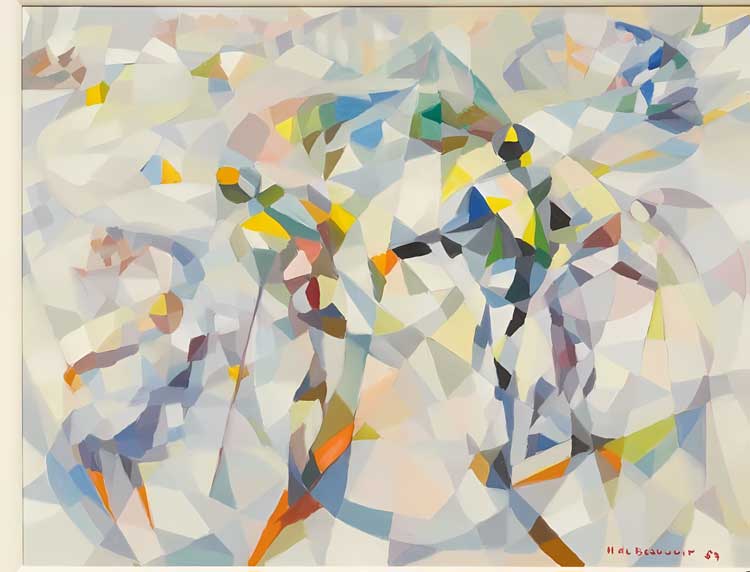
Hélène de Beauvoir. Skiers at a Standstill, 1957. Oil on canvas, 50.5 x 66 cm. Courtesy Amar Gallery, © APP, Ute Achhammer.
Skiers at a Standstill (1957) further exemplifies De Beauvoir’s use of this geometric fragmentation, this time with strong upright diagonals suggesting both legs and skis, and orange triangles to mark the feet. As already mentioned, however, movement is inherent to De Beauvoir’s work, and a further ski scene, Skipiste (1962), abandons this kaleidoscopic view in the midst of freely swirling snow and the whirl of speed in the skiers’ whooshing descent down the mountain.
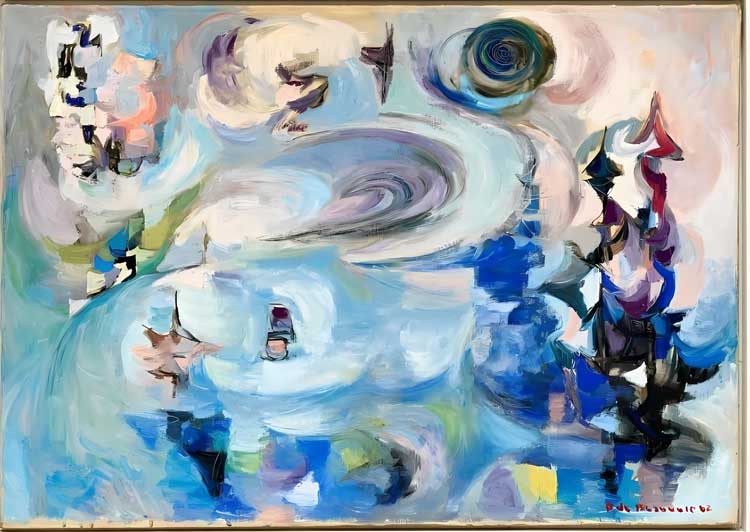
Hélène de Beauvoir. Skipiste, 1962. Oil on canvas, 65 x 92.3 cm. Courtesy Amar Gallery, © APP, Ute Achhammer.
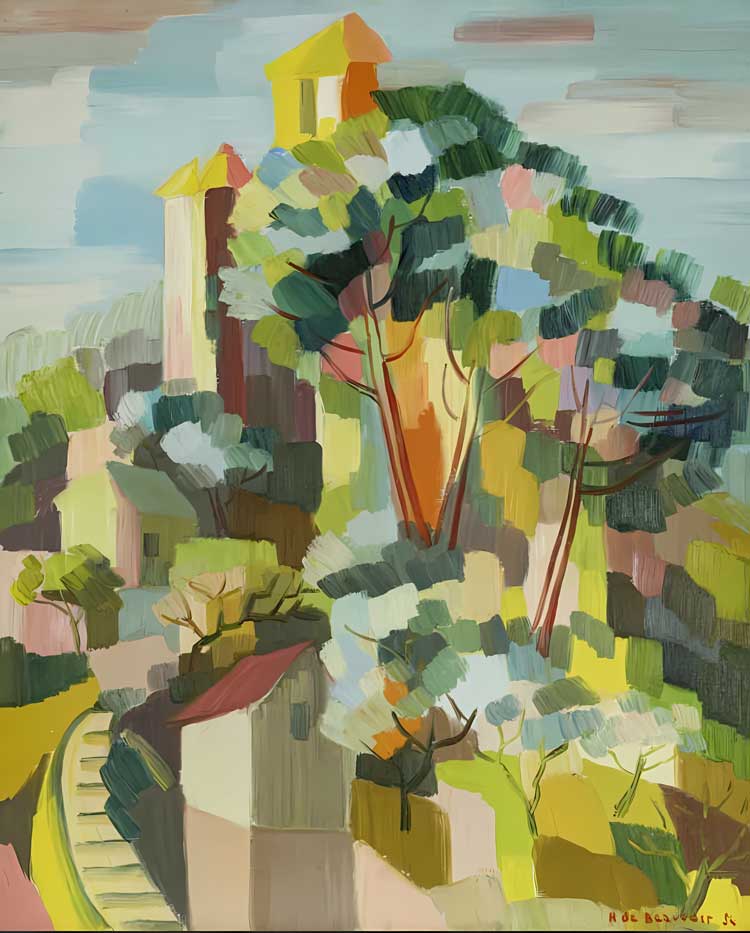
Hélène de Beauvoir. Castle in Alsace, c1960s. Oil on canvas, 75 x 60 cm. Courtesy Amar Gallery, © APP, Ute Achhammer.
Castle in Alsace (c1960s) is my favourite work on show, resolving the refracted fragments with simple, abstract mark-making, coming together to create a clearly figurative image, in a post-impressionist – almost expressionist – style. The beautiful array of lush greens evokes the fresh, verdant Alsatian trees – some clearly in the low, twisted shape of olive trees – and the yellows and reds capture the evening sun falling on the stone of the castle. I think of Cézanne, but, again, banish this comparison, holding on to the same fact as De Beauvoir herself, striving, above all, to remain, as Picasso had observed so early on in her career, “original”.
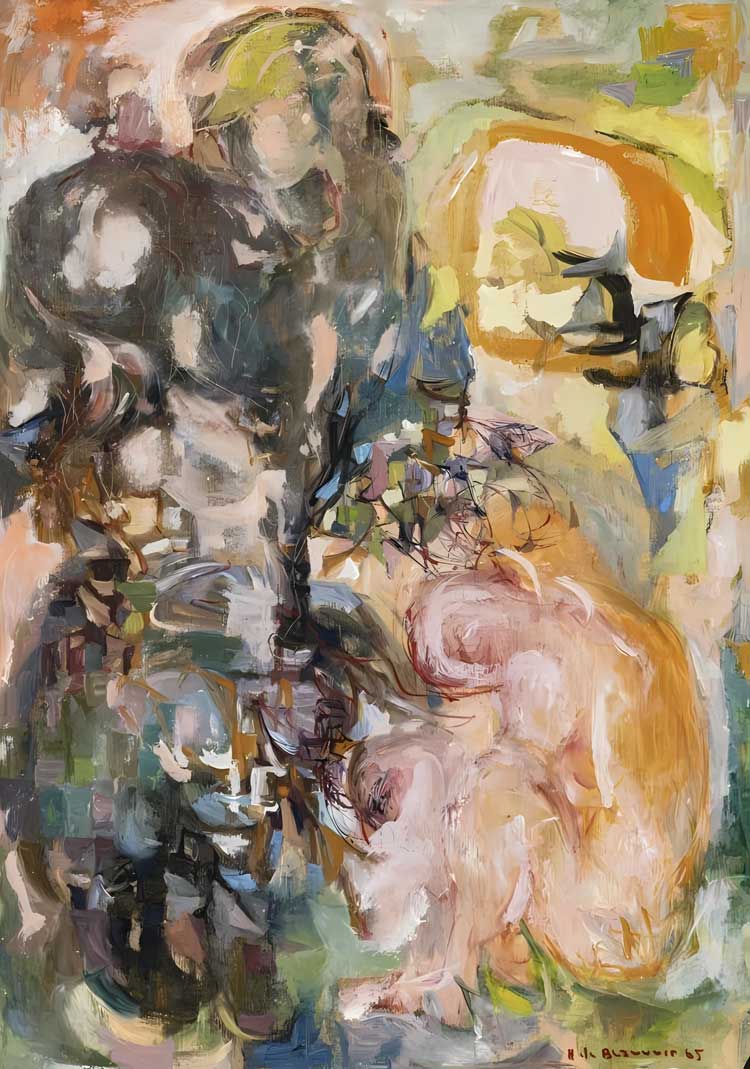
Hélène de Beauvoir. Nude with Horse, 1965. Acrylic on canvas, 92 x 65 cm. Courtesy Amar Gallery, © APP, Ute Achhammer.
Nude with Horse (1965) is unlike the other works as it elicits in me an uncomfortable feeling of oppression. Although De Beauvoir made more specific works on that theme, the crouching nude, in the foetal position, seems subjugated to the larger horse. Tigers and Chequerboards (1972), one of the latest works included, uses the motif of the tamed animal, as she writes in her memoir, “as a symbol of the clash between nature and civilisation”. She further describes pictures with tigers as “sad”, saying she has only ever seen these animals in captivity.21 This power struggle and constraining of a free spirit could be seen to echo Hélène’s relationship with Simone. Throughout her career, Hélène had continued to play second fiddle to her sister. For example, a successful vernissage at the Moulin Rouge, showing more than 30 paintings relating to the events of May 1968, was attended by dukes, duchesses and prostitutes alike. Nevertheless: “As usual, Hélène couldn’t avoid a few rude people who, seeing her sister there, insisted they be introduced. It happened at every opening.”22 Regardless, Hélène was never bitter, and she didn’t attempt to hide her relationship to her sister – nor to her sister’s partner, Sartre. In fact, Simone and Sartre wrote texts for the catalogue to the exhibition in Brest (1975). We have already seen something of what Simone wrote, but here is Sartre’s insightful paragraph: “The work shown by Hélène de Beauvoir today is the culmination of lengthy research. She discovered early on that by producing illusory work one fails to expect things: still, she loves nature – forests, gardens, lagoons, plants, animals and the human body – too much to forsake their inspiration. Between the vain restrictions of imitation and aridity of the purely abstract, she has created her own path. Loathing trompe l’oeil, she has deliberately rediscovered the naivety of the primitives who set their universe down on flat surfaces; but in this imaginary space, freed from the laws of perspective, the outline of a flower, a horse, a bird or a woman evokes reality. In Alice in Wonderland, a cat disappears leaving only a smile for the astonished onlooker; it is the same in the paintings of Hélène de Beauvoir, where joy and anguish emanate with gripping evidence from images whose outlines have not been traced. There is nothing gratuitous in these compositions, where form and background, inventions and evocations intermingle at their own dictates. Nevertheless, a blissful exuberance shines through the rigour. Beyond her collective inventions, the painter loses herself without reserve in the pleasure of painting, and that is why her work seduces us.”23
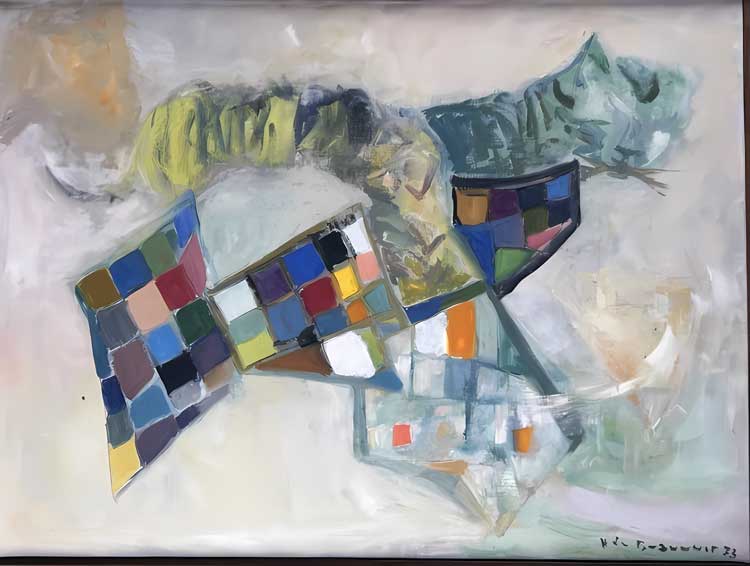
Hélène de Beauvoir. Tigers and Chequerboards. 1972. Oil on canvas, 50.5 x 65.2 cm. Courtesy Amar Gallery, © APP, Ute Achhammer.
Later in life than her sister, in her 60s, Hélène, too, became very involved in the women’s movement. She was made president of a refuge for female victims of violence in Strasbourg, a cause to which she dedicated herself increasingly, even testifying in court on the behalf of victims. On Sundays, she would receive these women and their children in her home for tea.24 Her view was that, having had the luck to lead a happy life, it was up to fortunate women like herself to help those who were less lucky.25 On occasion, Hélène dared claim that she had become a feminist before Simone. She spoke of her own experiences in the art world, noting that she signed her works as “H de Beauvoir” so that people didn’t immediately know her sex, and saying: “It is a macho world in which only men are taken seriously. The great painters have always had wives beside them who would handle the daily chores, thereby allowing their husbands’ ‘genius’ to fully bloom. We, on the other hand, have no wives to support us. Worse yet, our painting is seen as a hobby. Women painters are treated much less well than women in Simone’s profession. I’ve been talking to her about this for years, but nobody wants to hear it.”26 For whatever reason, Simone, for a long time, didn’t speak out about the situation of female artists, despite describing the struggles of women in many other professions. For the first time, 17 years after the publication of The Second Sex, she included, in a lecture that she held in front of 3,000 students in 10 packed lecture theatres in Tokyo: “It’s expensive to have a studio, to have plaster or marble, tubes of paint, canvases; these trades require a great deal of financial support. This support can sometimes be provided by friends and family. They’ll give it to a man, not a woman … I know the painting world pretty well, and I know that a collector or art dealer won’t bet on a young woman … He really thinks: she’s a young woman, so she has no talent.”27
Hélène was in San Francisco for the opening of an exhibition when Simone died in hospital in 1986. Lionel died four years later, in 1990, and Hélène outlived them both, living to be 91. She continued to paint, sometimes for six to eight hours a day, until she was 86 and underwent heart surgery. Her ensuing decline was a tragedy, not least because she was duped by a couple, who claimed to want to help promote her work and hold a great retrospective, but, in fact, stole her money, many engravings and 60 of her paintings, none of which have been recovered. Hélène de Beauvoir died impoverished – truly “the woman destroyed” – asking Monteil even on her deathbed: “Every now and then I still earn my living with my artwork. Simone would have been pleased, don’t you think?”28
References
1. The Beauvoir Sisters: An Intimate Look at How Simone and Hélène Influenced Each Other and the World by Claudine Monteil, translated by Marjolijn de Jager, Seal Press, 2004, page 2.
2. ibid, page 8.
3. ibid, page 2.
4. ibid, page 8.
5. Memoirs of a Dutiful Daughter by Simone de Beauvoir, translated by James Kirkup, Penguin, 1958, page 272.
6. Speech by Claudine Monteil at the vernissage of an exhibition of Hélène de Beauvoir’s work at Wurth Museum, France, 28 January 2018.
7. Op cit. Monteil, 2004, page 119.
8. Speech by Claudine Monteil at the opening of the exhibition at Amar Gallery, London, 25 January 2025.
9. Op cit. Monteil, 2004, page 16.
10. La Femme Rompue by Simone de Beauvoir, Editions Gallimard, 1967, published as The Woman Destroyed, translated by Patrick O’Brian, Harper Perennial, 2006.
11. Op cit. Monteil, 2004, page 85.
12. Op cit. Monteil, 2018.
13. Monteil, 2004, page 85.
14. Monteil, 2018.
15. Monteil, 2004, page 30.
16. Cited in Monteil, 2004, page 131.
17. ibid, page 16.
18. ibid, page 69.
19. Review in Arts, cited in ibid, page 62.
20. Review in Le Monde, cited in ibid, page 62.
21. “Das Talent Liegt in der Familie.” Die Malerin Hélène de Beauvoir by Karin Sagner, Hirmer, 2014, page 136, my translation.
22. Monteil, 2004, page 89.
23. ibid, pages 182-83.
24. Monteil, 2025.
25. Monteil, 2004, page 127.
26. ibid, page 120.
27. Monteil, 2018.
28. Monteil, 2004, page 193.